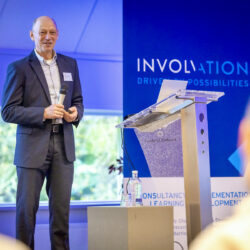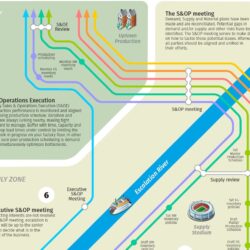IBP gets top priority at FrieslandCampina

What does Integrated Business Planning (IBP) add for a company that has already implemented Sales & Operations Planning (S&OP)? That was the main topic at the IBP conference organized by consultancy firm Involvation. Presentations and discussions centred on one company case: FrieslandCampina. IBP was given top priority there following the 2023 reorganization and the appointment of CEO Jan Derck van Karnebeek.
By Harm Beerens
“Most large manufacturing companies have been using S&OP for more than a decade and are now in phase two or three of Gartner’s S&OP maturity model,” said supply chain expert Hans van der Drift (pictured) of Involvation during his opening presentation. “S&OP has become a commodity, you could say. Companies have their supply and demand neatly balanced, and now the next step is to integrate it with the financial planning process. Thinking about volumes separately from finance leads to a lot of internal confusion in a company and, even worse, suboptimal decisions.” IBP is about aligning S&OP with the financial performance management cycle. The conference explained how to go about this.
Different profit margins
One company where the urgency for IBP is very clear is FrieslandCampina. As a dairy cooperative, it receives a large amount of milk every day. It can make many different types of end products from that, such as cheese, yoghurt and desserts, which also leads to all kinds of by-products (lactose, whey) that it can sell. These products are marketed in more than 100 countries and have different profit margins. The multinational carries its own brands, such as Milner, Optimel and Mona, produces under private label for other companies, and can sell its milk products on the commodity market. Van der Drift: “The aim is to make a mix of products every month that contributes optimally to the company’s profit. With S&OP alone, you won’t succeed.”
Everything must be right
FrieslandCampina’s case, which was discussed at the conference, shows how complex implementing IBP can be. The concept itself is actually not even that complicated, according to Van der Drift. It consists of a number of fixed building blocks such as forecasting, scenario planning, innovation alignment and a few other things. The challenge at FrieslandCampina stems mainly from dealing with such a huge organization – with business units, sales organizations, a marketing department, supply chain, etc. – all of which have to be aligned. “Everything has to be exactly right in terms of figures, otherwise you get discussions. And you have to introduce targets that transcend your own business unit or local level. Sometimes selling a particular product can reduce profit margins at national level, but improve profits at corporate level. You have to create a planning process that leads to the best financial decisions at all levels.”
Commitment from CEO
In the second part of the conference, Van der Drift’s colleague Teun Veldhuizen took the stage. As an executive advisor at FrieslandCampina, he is closely involved in IBP implementation. “A major restructuring of the company was announced by the management at the end of 2022. Before we could proceed with IBP, we had to reset the S&OP processes to bring them back in line with the new organizational structure. After all, S&OP is the foundation for IBP, so we put a lot of focus on that. What helped enormously here is that the new CEO saw the introduction of IBP as a top priority. During an hour-long webinar, he personally let all departments in the company know how important he thought it was. Commitment from the top is a crucial success factor in an IBP project.”
Wrapped in humour
During his presentation, Veldhuizen elaborated on the change management aspects of S&OP and IBP. “For many employees, this is complex stuff, so you have to try to wrap your message in humour. For example, we came up with sales, product and finance characters that caricatured the prejudices of other departments: a marketing director wearing a hoody, or a boastful sales director exaggerating everything. This can relieve tension and help people to become more self-reflective.” Another tip he gave was to let employees think for themselves how they can make a positive contribution to the IBP project. “As a joke, we printed this on a wall tile and gave it to the employees to regularly remind them of it afterwards.
Modelling scenarios
In parallel to the introduction of the IBP process, FrieslandCampina is also implementing new supply chain planning software. The company currently works with SAP APO, but this will be replaced in phases over the next few years by OMP’s planning tools. These new tools will first be used for next-gen demand planning, then for supply planning and then also for S&OP.
Van der Drift: “Such a tool will make it much easier to model scenarios, among other things. Say FrieslandCampina is considering a major promotional campaign, they can use such a tool to calculate all the end-to-end results and costs. Now everyone is quick to say ‘just do it’, but then you can compare different options side by side – such as what if we didn’t do the promotion, what if we did it earlier or later, etc. Based on these scenarios, you can make the right choices during your IBP meetings and make the best financial decisions.”










